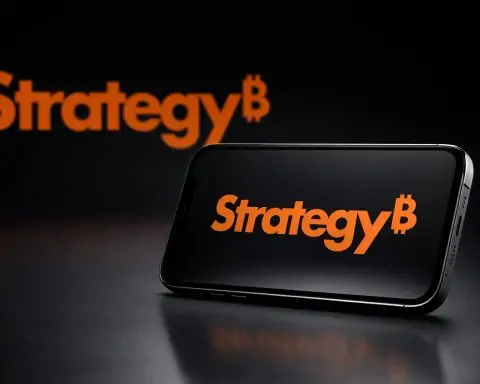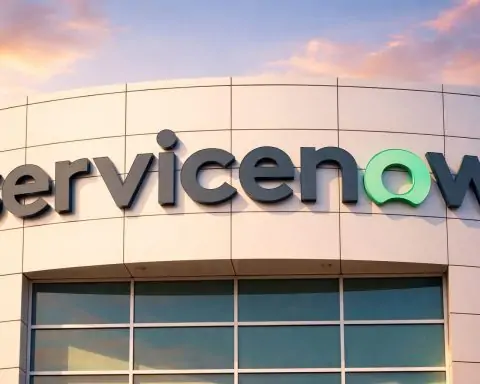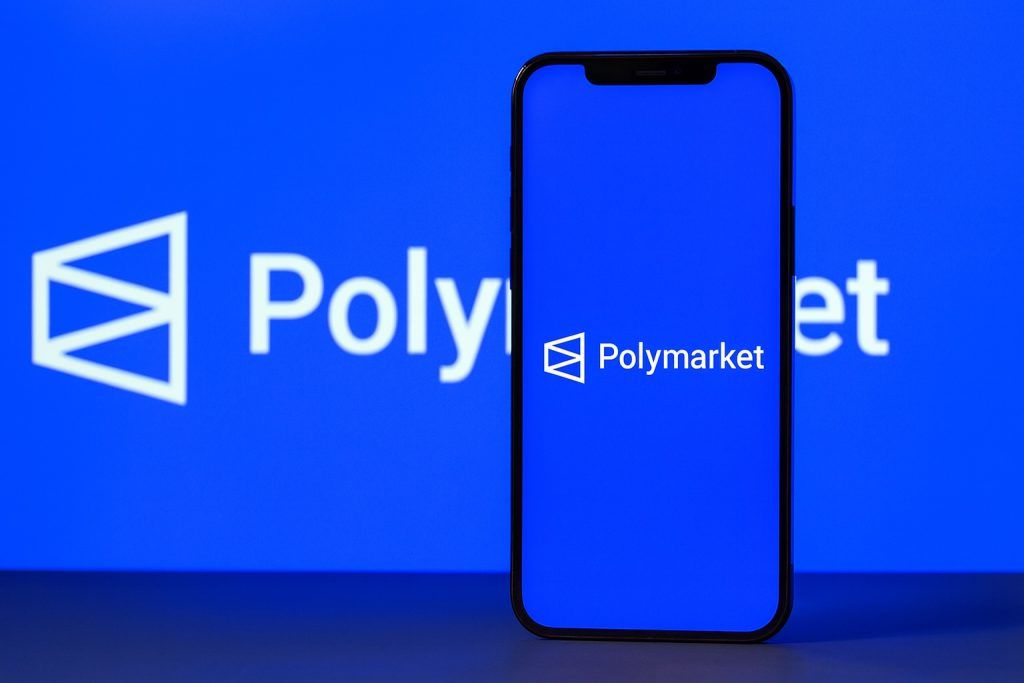- Historic U.S. Approval: The U.S. government has approved a first-of-its-kind export license allowing Microsoft to ship Nvidia’s most advanced AI chips to the United Arab Emirates (UAE) [1]. Licenses granted in September 2025 under “stringent” safeguards enable shipment of ~60,400 Nvidia GPUs – equivalent to A100 chips, including Nvidia’s latest GB300 “Grace Blackwell” processors – for use in UAE data centers [2].
- Nvidia Stock Jumps:Nvidia shares surged about 3% on Monday after news of the UAE deal broke, as investors cheered the expanded market for its AI chips [3]. Microsoft’s stock also ticked up slightly on the announcement [4]. Analysts see the export approval as a sign of robust international demand, with one firm even raising its price target for Nvidia to $300 amid the optimism [5].
- Microsoft’s Big UAE Investment: Microsoft is pouring $15.2 billion into the UAE by 2029 to expand cloud and AI infrastructure [6] [7]. The tech giant’s Vice Chair Brad Smith says “the biggest share” of this investment is expanding AI data centers across the UAE to meet surging regional demand for artificial intelligence [8]. Microsoft already invested $1.5 billion in 2024 for a stake in local AI firm G42, part of its strategy to embed in the UAE’s tech ecosystem [9].
- Boosting an Emerging AI Hub: The UAE has spent billions to establish itself as a global AI hub [10]. Access to Nvidia’s cutting-edge chips will supercharge projects like a planned AI supercomputing campus in Abu Dhabi (stalled until now by chip export curbs) [11]. Experts call Nvidia’s GPUs “crucial” for the UAE’s ambitions, giving local developers a leading edge in a highly competitive field [12]. Microsoft says the imported chips will power advanced AI services – from OpenAI’s and Anthropic’s models to Microsoft’s own AI tools – for users in the UAE [13].
- Strategic Deal Amid Tech Tensions: This U.S.-UAE tech partnership comes with strict safeguards and geopolitical stakes. It was personally endorsed by President Donald Trump’s administration in a bid to deepen ties with an ally while countering Chinese influence in the Middle East [14]. UAE officials tout the arrangement as a new “Gold Standard” for secure AI cooperation [15]. However, the deal appears to contradict President Trump’s public stance that America’s “most advanced [chips]… we will not let anybody have them other than the United States” [16], highlighting how exceptional this approval is.
U.S. Greenlights Advanced AI Chip Exports to the UAE
In a groundbreaking move, the U.S. Commerce Department approved special export licenses for Microsoft to ship thousands of Nvidia’s top-tier AI chips to the UAE [17]. This marks the first time a U.S. company has been cleared to send such advanced GPUs to the Gulf nation under updated export rules [18]. The approval, granted in late September 2025, was contingent on “updated and stringent technology safeguards” to ensure the hardware is used responsibly and doesn’t fall into the wrong hands [19]. Microsoft hailed the decision in a blog post, emphasizing that “while the chips are powerful and the numbers are large, more important is their positive impact across the UAE” [20].
What’s being shipped? The licenses cover an additional 60,400 Nvidia AI chips (on top of thousands already in use) [21]. In practice, this means Microsoft can deliver tens of thousands of Nvidia’s latest data-center GPUs – including the new GB300 “Grace Blackwell” chips – to fuel AI systems in the UAE [22]. These GB300 chips represent Nvidia’s most advanced processors for artificial intelligence tasks. Notably, such top-end chips have so far been kept mostly within the U.S. or allied nations, as Washington tightly controls exports of high-performance AI hardware, especially to strategic rivals. The UAE’s approval is a significant exception.
Why the special treatment? U.S. officials view the UAE as a key Middle Eastern ally and a burgeoning technology hub. The export greenlight followed a high-profile agreement in May 2025 between President Trump and UAE President Sheikh Mohamed bin Zayed to collaborate on an AI mega-campus in Abu Dhabi [23]. That project had stalled under previous U.S. chip export curbs, but now it’s moving forward. By enabling the UAE to access cutting-edge American chips, Washington aims to bolster an ally’s tech capabilities while keeping them aligned with U.S. (not Chinese) technology platforms [24]. “This decision opens doors to international markets while maintaining U.S. influence,” notes The National CIO Review, pointing out that it lets American firms support global AI growth under government-approved safeguards [25].
However, the deal isn’t without controversy. In a “60 Minutes” TV interview aired just a day before the announcement, President Donald Trump asserted that Nvidia’s most advanced AI chips should be reserved for U.S. use only, saying “The most advanced, we will not let anybody have them other than the United States” [26]. Those remarks underscore the administration’s hard line on protecting critical tech – and make the UAE license look all the more extraordinary. The White House has not commented in detail on why the UAE was granted an exception, but the arrangement is tied to extensive security conditions and reciprocal benefits (as discussed below). Congress is watching closely too: “I welcome the prospect of closer U.S. tech collaboration with the UAE – but it needs to come with the Emiratis verifiably and irreversibly choosing America,” cautioned Rep. John Moolenaar, who chairs a House committee on China, alluding to concerns about the UAE’s ties with Beijing [27]. In short, the UAE chip deal is a unique case, balancing strategic alliance-building against the backdrop of a global tech rivalry.
Microsoft’s $15 Billion Bet on UAE’s AI Future
The chip export approval comes alongside a massive commitment by Microsoft to invest in the UAE’s tech sector. Microsoft announced it will boost its total UAE investment to $15.2 billion by 2029, up from roughly $7.3 billion spent since 2023 [28] [29]. According to Microsoft President Brad Smith, the lion’s share of this investment is going into AI data centers across the UAE [30]. “From our perspective, it’s an investment that is critical to meet the demand here for the use of AI,” Smith said, highlighting the explosive growth in regional AI needs [31]. By building out cutting-edge cloud infrastructure locally, Microsoft can deliver advanced AI services directly from UAE soil.
This expansion builds on partnerships Microsoft has already forged in the Emirates. Last year, Microsoft invested $1.5 billion for a minority stake in Abu Dhabi-based AI firm G42 [32], giving Microsoft a seat on G42’s board (held by Brad Smith himself). G42 is known for its work on large-scale cloud computing and AI (it helped develop the “Falcon” AI model renowned in the Middle East). The tie-up was strategic: it aligned Microsoft with the UAE’s top AI players, but it also raised eyebrows in Washington. G42 had past links to China, sparking U.S. scrutiny over whether American tech might indirectly reach Beijing via the UAE [33]. Microsoft and UAE officials have addressed these concerns by implementing rigorous compliance systems. G42 “made enormous progress” on safeguards to meet U.S. legal standards, Smith noted, adding that he expects G42 will eventually have direct access to advanced U.S. chips as part of its future – presumably once trust and verification measures are firmly in place [34].
Where is the money going? Microsoft’s investment will fund new data center campuses, AI research hubs, and cloud services infrastructure across the UAE [35] [36]. At least $5.5 billion is earmarked for capital expenditures on AI and cloud infrastructure (servers, chips, facilities), and $1.5 billion went into the G42 equity stake as noted [37]. One flagship project is the “Stargate” data center hub announced in Abu Dhabi – envisioned as one of the world’s largest data center complexes. Interestingly, Microsoft says none of its newly announced $15.2 billion investment will go into the first phase of Stargate [38], suggesting that project may be funded separately (possibly by G42 or the UAE government) or in later phases. Instead, Microsoft’s immediate focus is on expanding its own Azure cloud regions in the UAE and integrating those thousands of Nvidia GPUs into its facilities. By doing so, Microsoft can locally serve UAE customers – government agencies, businesses, researchers – with advanced AI capabilities via Azure and OpenAI’s tools, without data having to leave the country. This aligns with the UAE’s goal of digital sovereignty, keeping critical AI development within national borders but underpinned by American tech.
From Microsoft’s perspective, this bet on the UAE could pay off significantly. The Gulf region has “some of the highest per-capita usage of AI” in the world, the company noted [39]. UAE organizations are eager for AI-driven services in everything from energy to finance to government – meaning strong demand for cloud AI solutions. Microsoft is effectively turning the UAE into a regional AI computing hub servicing not just one country but potentially customers across the Middle East and beyond. And by being the first to deliver ultra-sophisticated chips here, Microsoft gains a competitive edge over rivals in the cloud/AI market (like Amazon or Google) in this geography.
Brad Smith has also framed this initiative in idealistic terms: ensuring that the “AI revolution” is globally inclusive. He warned that without investments in regions like the Middle East and Africa, AI capabilities could remain concentrated in a few countries, exacerbating global inequality [40]. By spreading AI infrastructure to new markets, Microsoft positions itself as a partner in broader economic development. In Smith’s words: the distribution of AI tools across regions will determine whether AI becomes “a widely beneficial technology or one that further divides economies” [41]. This philosophy dovetails with the UAE’s own national strategy to become a leader in AI while bridging the digital divide.
Nvidia Stock Soars and Analysts See Upside
News of the U.S.-UAE chip deal was music to investors’ ears – especially those betting on Nvidia, the semiconductor juggernaut supplying the AI chips. Nvidia’s stock jumped roughly 3% intraday on the announcement [42], adding to its already stellar gains in 2025. The market’s reaction reflects the significance of opening a new high-end market for Nvidia’s GPUs. Each A100/H100-class chip sells for tens of thousands of dollars, and the UAE order (over 60,000 GPUs) could be worth billions of dollars in revenue over time. It’s effectively a new, U.S.-approved export market for Nvidia at a time when direct sales to China – formerly a huge buyer of AI chips – are heavily restricted by U.S. policy. Replacing some of that lost China demand with orders from U.S. allies like the UAE is a bullish signal for Nvidia’s growth [43].
Wall Street analysts took note. Cantor Fitzgerald promptly raised its price target for Nvidia from $240 to $300 in light of the UAE deal and overall robust AI chip demand [44]. The firm maintained an “overweight” rating, implying Nvidia stock is still a buy despite its big run-up. Analysts at Cantor and elsewhere see Nvidia’s pipeline of orders remaining strong as governments and corporations worldwide race to build AI capabilities – and almost all rely on Nvidia’s cutting-edge GPUs as the silicon backbone. The UAE license news reinforced that Nvidia’s premier chips remain the gold standard globally and that even U.S. export controls can be navigated if the buyer is a trusted partner with deep pockets.
Beyond this single deal, Nvidia’s longer-term outlook still appears bright. The company is expected to launch its next-generation “Blackwell” GPU line (the very chips in the UAE deal) in 2025-2026, promising even greater performance for AI training. Demand for these is anticipated to be enormous among cloud providers and AI labs. “Access to the world’s leading AI chips provides the hardware that will give developers the leading edge,” observed Azad Zangana, an Oxford Economics analyst, in reference to the UAE obtaining Nvidia hardware [45]. That edge is exactly what countless other countries and companies are seeking – which suggests Nvidia’s order books will stay full well into the future.
However, investors are also mindful of geopolitical risks. Any sign of policy reversal – for instance, if Washington decided to clamp down even on allied nations’ access to top chips – could hit Nvidia’s prospects. For now, the UAE deal indicates a balanced approach: the U.S. is willing to approve exports in select cases, which could mean more deals with other allies (like possibly Saudi Arabia or Japan) might follow. Each such approval would open new markets for Nvidia. As long as the AI revolution continues and Nvidia keeps its technological lead, many market watchers predict its stock will remain on an upward trajectory. Some caution that the stock’s valuation is already rich, but catalysts like new government orders or product launches could justify the optimism. In summary, Nvidia’s short-term boost from the UAE news feeds into a larger long-term narrative of strong global AI chip demand, keeping analysts bullish on the company’s fortunes [46].
Why the UAE? Geopolitics and AI Ambitions
The United Arab Emirates has emerged as a surprising beneficiary of U.S. high-tech exports. At first glance, the UAE obtaining what China cannot sounds almost like a geopolitical loophole. In reality, it’s the result of strategic calculus on both sides. The UAE is aggressively positioning itself as a global AI leader, and it has something valuable to offer in exchange for U.S. tech: deep economic partnership and alignment with U.S. interests. UAE officials have been keen to assure Washington that they’re a trusted steward of American technology. Earlier this year, Yousef Al Otaiba, the UAE’s ambassador to the U.S., praised the nascent chip arrangement as “setting a new ‘Gold Standard’ for securing AI models, chips, data and access” [47]. In other words, the UAE is holding itself to high transparency and security standards to allay U.S. fears. The Emirates has reportedly agreed to conditions like hosting the chips in Microsoft-run data centers (so they remain under an American company’s control), strict rules against sharing technology with third parties, and perhaps even on-site U.S. monitoring or audits as needed [48].
Why go to these lengths? For the UAE, the payoff is huge: being one of the few countries with access to the world’s most powerful AI hardware. This access can accelerate their ambitions in everything from advanced research to smart city initiatives. The UAE has already made bold moves, such as appointing the world’s first minister of AI and investing heavily in homegrown AI projects. It also pledged an eye-popping $1.4 trillion investment into U.S. energy and AI projects over time [49] – a commitment that far exceeds the UAE’s annual GDP, signaling how serious they are about this partnership. That pledge, revealed in Washington, underscores a broader tech-for-investment deal: the UAE pours money into ventures that benefit the U.S. economy, and in return it gets access to critical tech and know-how.
From the U.S. perspective, strengthening the UAE’s tech prowess serves as a counterweight to China’s influence in the Middle East. In recent years, Chinese tech companies and infrastructure projects have made inroads in the Gulf. Allowing the UAE to source its AI needs from American firms instead helps box out Chinese vendors and deepens the UAE’s dependency on U.S. technology [50]. It’s a soft power win for Washington: rather than ceding the AI race in emerging markets to Beijing, the U.S. can cultivate its own tech spheres of influence. There is also a security dimension. By having American companies like Microsoft operate the AI data centers in the UAE, the U.S. can maintain some oversight and ensure those resources aren’t misused or diverted. This addresses concerns that advanced chips could otherwise be resold or transferred to hostile actors (a key worry behind the strict export controls).
That said, the arrangement is being watched carefully. U.S. lawmakers want assurances that UAE’s cooperation is ironclad. Any hint that restricted technology might leak from the UAE to embargoed countries would imperil the deal. The UAE, for its part, appears motivated to keep the trust: it gains more by partnering with the U.S. than by risking a breakdown in relations. As analyst Azad Zangana noted, the UAE’s “push to be a major global player in AI” is heavily dependent on access to U.S. chips and expertise [51] – so it has a strong incentive to abide by the rules of this new “gold standard” framework.
In broader terms, the UAE deal could serve as a template for other U.S. allies seeking advanced AI hardware. Nations like South Korea and Israel, or European partners, might point to the UAE case when lobbying Washington for similar treatment. (In fact, Nvidia has said it plans to supply its Blackwell chips to South Korea’s tech firms, which presumably also requires U.S. sign-off [52] [53].) Each scenario will be weighed on its own merits, but the UAE example shows a pathway: close diplomatic ties, joint projects, and robust safeguards can make a compelling case for exceptions to export restrictions.
Conclusion
The U.S.-UAE AI chip deal represents a pivotal intersection of technology, business, and geopolitics. It unlocks cutting-edge computing power for the UAE’s aspiring AI industry, handing a friendly nation tools that were until now jealously guarded. In return, U.S. companies like Microsoft and Nvidia gain lucrative new business, and Washington strengthens its tech alliance in a critical region. This balance – enabling innovation abroad while protecting national security – is delicate, but the early signs are promising.
For Nvidia, the world’s most valuable chipmaker, the message is that demand for its AI silicon remains insatiable and increasingly global. Its stock price reflects that optimism, and expert forecasts project sustained growth as AI adoption spreads [54]. For Microsoft, a $15+ billion bet on UAE’s digital future could cement its position as the dominant AI cloud provider in the Middle East, paying dividends for years to come. And for the UAE, gaining access to America’s top AI technology is a leap forward in its quest to be the “Silicon Oasis” of the Arab world – all while staying in Washington’s good graces.
Yet, this deal also sets a precedent that will be tested. It blurs the line in U.S. policy between “America’s tech advantage” and the benefits of tech diplomacy. How far will the U.S. go in sharing its crown-jewel technologies with partners? The answer will likely evolve, influenced by the success or failure of this very partnership. If the UAE’s AI leap yields economic growth and innovation – without compromising U.S. tech security – it could pave the way for a new era of AI-era alliances. As one official put it, it’s about ensuring AI’s promise is broadly shared: either artificial intelligence becomes a widely beneficial technology, or one that further divides economies [55]. The stakes of the UAE chip deal suggest that, with careful collaboration, both countries are betting on the former – an AI future that they build together, to mutual benefit.
Sources: CNBC [56] [57]; Reuters [58] [59]; AP News [60] [61]; The National CIO Review [62] [63].
References
1. nationalcioreview.com, 2. www.osoulmisrmagazine.com, 3. www.osoulmisrmagazine.com, 4. www.osoulmisrmagazine.com, 5. www.ainvest.com, 6. www.reuters.com, 7. www.reuters.com, 8. www.reuters.com, 9. www.reuters.com, 10. www.reuters.com, 11. nationalcioreview.com, 12. www.osoulmisrmagazine.com, 13. www.osoulmisrmagazine.com, 14. nationalcioreview.com, 15. apnews.com, 16. apnews.com, 17. www.osoulmisrmagazine.com, 18. www.osoulmisrmagazine.com, 19. www.osoulmisrmagazine.com, 20. www.osoulmisrmagazine.com, 21. www.osoulmisrmagazine.com, 22. www.osoulmisrmagazine.com, 23. nationalcioreview.com, 24. nationalcioreview.com, 25. nationalcioreview.com, 26. apnews.com, 27. www.reuters.com, 28. www.reuters.com, 29. www.reuters.com, 30. www.reuters.com, 31. www.reuters.com, 32. www.reuters.com, 33. www.reuters.com, 34. www.reuters.com, 35. nationalcioreview.com, 36. nationalcioreview.com, 37. nationalcioreview.com, 38. www.reuters.com, 39. apnews.com, 40. nationalcioreview.com, 41. nationalcioreview.com, 42. www.osoulmisrmagazine.com, 43. nationalcioreview.com, 44. www.ainvest.com, 45. www.osoulmisrmagazine.com, 46. www.ainvest.com, 47. apnews.com, 48. nationalcioreview.com, 49. apnews.com, 50. nationalcioreview.com, 51. www.osoulmisrmagazine.com, 52. www.reuters.com, 53. www.reuters.com, 54. www.ainvest.com, 55. nationalcioreview.com, 56. www.osoulmisrmagazine.com, 57. www.osoulmisrmagazine.com, 58. www.reuters.com, 59. www.reuters.com, 60. apnews.com, 61. apnews.com, 62. nationalcioreview.com, 63. nationalcioreview.com







